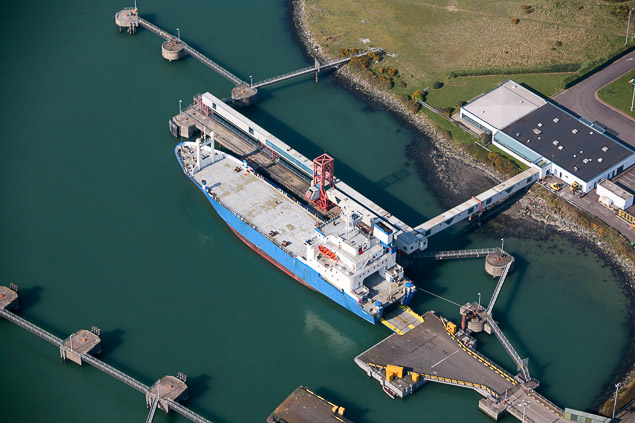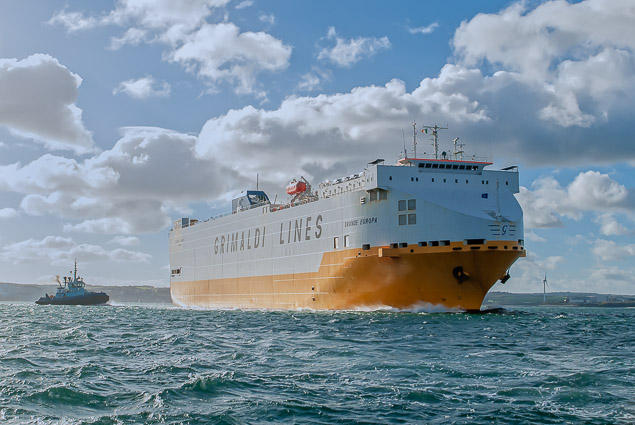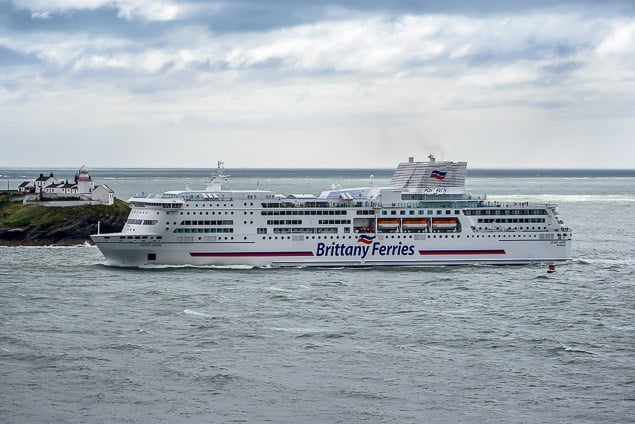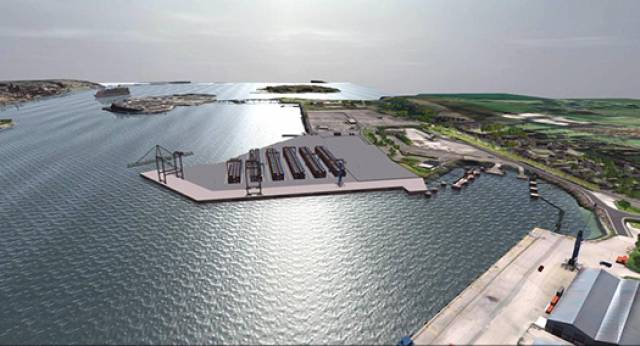The Port of Cork marked a major milestone for the company today with the launch of the new Cork Container Terminal development in Ringaskiddy, as Afloat.ie first reported in 2015.
The Cork Container Terminal will initially offer a 360 metre quay with 13 metre depth alongside and will enable larger ships to berth in Ringaskiddy. The development also includes the construction of a 13.5 hectare terminal and associated buildings as well as two ship to shore gantry cranes and container handling equipment.
 A ship berthed upriver at the Port of Cork at Custom House Quay Photo: Bob Bateman
A ship berthed upriver at the Port of Cork at Custom House Quay Photo: Bob Bateman
The requirement for the development of new container handling facilities at Ringaskiddy was identified in the Port of Cork’s Strategic Development plan in 2010. It will accommodate current and future container shipping which can be serviced by modern and efficient cargo handling equipment with innovative terminal operating and vehicle booking systems. The Port of Cork anticipates that Cork Container Terminal will become operational by 2020.
Chairman of the Port of Cork, Mr John Mullins said: “The Port of Cork’s redevelopment at Ringaskiddy is a key growth enabler for both Cork city and region as well as the national economy and will enable the Port to deliver more efficient container handling facilities, replacing the existing container terminal at Tivoli, and securing the Cork Container Terminal as an international gateway for trade well into the future.
 The existing deepwater berth at Ringaskiddy is being developed Photo: Bob Bateman
The existing deepwater berth at Ringaskiddy is being developed Photo: Bob Bateman
He continued: “The transfer of Port-related activities from the city and Tivoli will create a real opportunity for Cork Dockland sites to be redeveloped in the near future.”
This state of the art facility is the most significant single investment in marine infrastructure and superstructure in the history of the Port of Cork Company. Representing an investment of €80 million, the development is being funded by the Port through an innovative and award-winning financing structure comprising Allied Irish Banks, p.l.c, the European Investment Bank, and the Ireland Strategic Investment Fund (ISIF), and also by including European Union Connecting Europe Facility funds and self-finance.
 A massive Car Carrier arrives into Cork Harbour Photo: Bob Bateman
A massive Car Carrier arrives into Cork Harbour Photo: Bob Bateman
The Port of Cork awarded the development’s civil engineering contract to BAM Civil Ltd., part of the multi-national construction group, Royal BAM Group of the Netherlands.
Port of Cork Chief Executive, Brendan Keating said: “This development will secure the future for the Port of Cork, and ensure the trade gains are translated into significant economic benefits for the people of Cork and the Munster region, as well as the national economy. As part of this redevelopment the Port of Cork will deliver a public marine leisure amenity at Paddy’s Point and has also committed a €1 million community gain fund for the Ringaskiddy area for the development of an enhanced public realm scheme. We look forward to supporting the community and Cork County Council as they prepare and implement the scheme.”
Donal Murphy, Head of Infrastructure and Credit Investments at ISIF said: “This is an important investment for ISIF that demonstrates our commitment to investing in key infrastructure throughout Ireland on a commercial basis. It is the latest investment from our Connectivity Fund, which was established with proceeds from the sale of the State’s shareholding in Aer Lingus.
ISIF is using its ability to act as a long-term provider of capital to back the Port of Cork with flexible funding that is tailored to its specific needs. We expect this investment will underpin significant economic activity in the southern region. It will also enhance Ireland’s transport and supply chain links with major EU markets and help Irish exporters to access these markets post-Brexit.”
 The Brittany Ferries flagship Pont Aven is a weekly runner into Ringaskiddy Photo: Bob Bateman
The Brittany Ferries flagship Pont Aven is a weekly runner into Ringaskiddy Photo: Bob Bateman
Conor Morgan, AIB Corporate Banking said “As the Port of Cork’s long-term relationship bank, AIB Corporate Banking is delighted to provide this financing for the Port of Cork to back their strategic development at Ringaskiddy Port. Following a funding process of over two years, an innovative transaction structure was put in place involving senior debt from AIB and EIB and junior debt from ISIF. As a key infrastructure deal supporting the growth of the Irish economy, the project increases future capacity at the port and brings major strategic value to the city of Cork and the Munster region.”
Andrew McDowell, European Investment Bank Vice President said “The redevelopment of Ringaskiddy will transform links between Ireland, Europe and the world, support exports by Irish business and create a world-class maritime logistics hub. The European Investment Bank is pleased to provide a EUR 30 million 18 year long-term loan alongside financing from leading Irish institutions for this crucial investment for Cork and Ireland. EIB support reflects the economic benefits and urban redevelopment to be unlocked in the coming years and the importance of ensuring alternative transport routes given export growth and ongoing uncertainties related to Brexit.”






























































